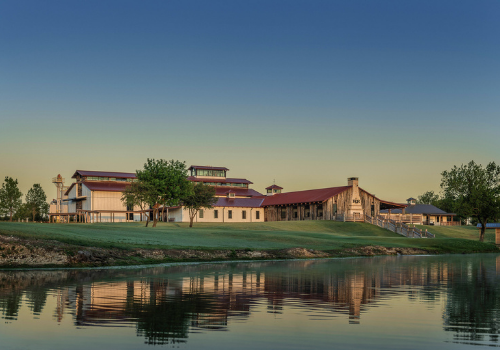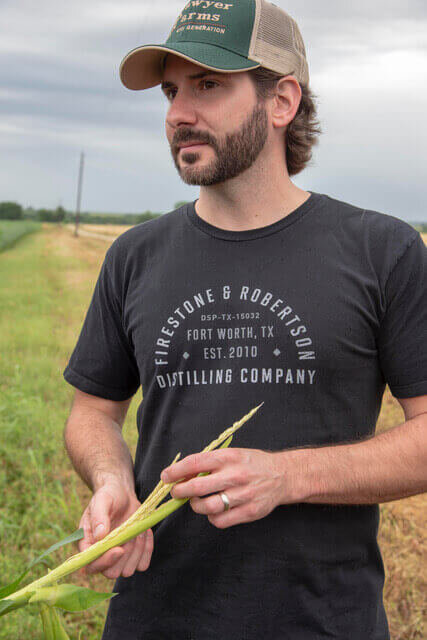The Terroir of Whiskey: A Distiller's Journey Into the Flavor of Place Book Review
Firestone & Robertson Whiskey Ranch
The Terroir of Whiskey is Rob Arnold’s quest to understand terroir and, eventually, to demonstrate that it is meaningful. It covers several years during which Arnold conducted research, visited wineries and distilleries, and interviewed scientists and whiskey makers – all while gradually nudging his employer distillery Firestone & Robertson into a terroir model. The inspiration for his prose is the work of writers like Michael Pollan (The Omnivore’s Dilemma) and Dan Barber (The Third Plate: Field Notes on the Future of Food), who have written deeply technical books about the science and anthropology of food that nonetheless became best sellers.
Rob Arnold calls himself a “third-generation member of the whiskey industry.” His grandfather held a senior position at Brown-Foreman, and nearly every one of his uncles and grand-uncles on his mother’s side worked in Bourbon. He was a biochemistry PhD candidate at the University of Texas when he decided maybe medical research wasn’t his true calling. He dropped out to become the first employee of Firestone & Robertson Distillery in Ft. Worth.
The distillery’s founders, Leonard Firestone and Troy Robertson, had visited Kentucky and been impressed by each distillery’s development and use of proprietary yeast. They decided finding and isolating a yeast indigenous to Texas would make a good story element for their new brand’s marketing. They assigned the job to Arnold.
“I had never done that,” he says. “My background was isolating marine bacteria from ocean sediment.”
Arnold’s “yeast hunt” turned into an all-out obsession with terroir, the impact of place on any agriculturally derived product. He is now simultaneously the distiller at Firestone & Robertson and a graduate student conducting research at Texas A&M University. His book, The Terroir of Whiskey, written as a first-person narrative, is a must-read for anyone interested in what is quickly becoming whiskey’s Next Big Thing.
Terroir – pronounced “ter-WAH” – is a French term, and it is the organizing principle of the world’s wine business. It is basically the belief that farm produce is endowed with unique properties by the soil, climate, and topography of the land on which it is produced. Craft distillers like it because it’s something they can offer their customers that big distillers can’t. Marketers like that it aligns conveniently with the Millennial and Gen Z obsession with authenticity, and theoretically provides what they like to call a “sustainable competitive advantage”: the ability to claim that a product is uniquely better than the competition in ways that can never be replicated. The concept of terroir is a driving factor in explaining why wine produced in the Domaine Romanée Conti vineyard in Burgundy sells for $2000 a bottle, and wine from vines only a few meters up the hill sell for only $70.
In whiskey, the primary mechanism of terroir is grain, and the amount of manipulation whiskey undergoes between field and bottle calls into question terroir’s significance. Writer and consultant Robin Robinson, perhaps the most prominent terroir skeptic, has written, “You’re putting (the agricultural product) into a fermented stew, which is then heated with catalytic effect in a pressurized, closed environment made of metal copper, and then distilled and taken apart in cuts and finally put into a barrel. As soon as you light the fire under the pot, that’s the end of terroir.”
Arnold does a good job of making organic chemistry accessible, pulling fascinatingly nerdy information from his own experience and researchers around the world. He pads their big words with his small stories about the people who are trying to crack the terroir nut, like this about touring potential grain suppliers around the Firestone & Robertson distillery:
“Nine of the farmers had the same reaction as every other tour-goer, equally intrigued and surprised by the complexity of whiskey making. But one farmer was much more observant than the others. He seemed already to understand the process. When he tried the new-make bourbon—the unaged, straight-from-the-still, 135-proof white dog spirit that tastes very different than mature bourbon—he didn’t wince or gasp like the others. He took his time to experience the flavors, and the strength didn’t seem to bother him. I knew he knew whiskey.
Near the end of the tour, I found him opening up our bins to inspect our grain. As I walked up, he turned to me and confidently said, “I can do better.””
One of the problems of terroir is there is no definitive answer to where it begins and ends. Arnold struggles a little with that and eventually settles into an expansive definition of terroir.
“It was more than just the environment,” he writes. “It was the overall ecological system of a farm or vineyard, that complicated interplay of nature and nurture.”
You can argue with that. I certainly would, preferring more nature and less nurture. But what’s significant about this, from the standpoint of the reader, is not Arnold’s conclusions, but his journey to understanding. In telling his story, he provides all the background anyone could want about the origins of terroir, how it fits into the whiskey business, and how to tell the true terroirists from the marketing-driven hypesters. And, in the process, he makes a strong case that, however you define terroir, it is definitely something that is going to influence the making of whiskey going forward.
Arnold looks at terroir as a producer, not as a consumer. For producers, it adds a meaningful dial on the complicated control panel that turns grain into whiskey. It is one more set of variables to manipulate, the results measured not in whiskey’s quality but in its character. Attention to it, according to Arnold, gives whiskey makers the creative space to incorporate new aromas and flavors into their product.
“We can select for particular flavors from our grains,” Arnold told me in an interview. “We can introduce unique new varieties of whiskey. It doesn’t mean better; it just means different. The wine industry has given us the blueprint. We can take inspiration from what they’ve done.”
Firestone & Robertson Distillery
In the vineyards of Europe, it has taken literally hundreds of years to identify terroir that produces wine of such distinction that it commands a premium price. It is a virtual certainty that terroir will eventually have that kind of effect on whiskey markets – if the marketers have their way, sooner rather than later. A handful of distilleries around the United States are configuring their operations to “express” their terroir, going through what is essentially the same exploratory process Arnold has captured beautifully in this book. They’re dedicated to producing unique whiskey that can’t be replicated by others.
In the end, Arnold goes beyond the effects of terroir on whiskey and is captured by the societal implications of what he’s advocating. Under the current system, farmers live or die based on yield per acre. The notion of quality is limited to a few basic variables, like water content and the impurities (husks, stones) mixed in with the grain. But in a terroir-driven grain economy, it is entirely possible that “quality” will come to mean something else entirely, and that yield will be sacrificed in order to create grain with specific chemical attributes.
The book begins with inexperienced Arnold not really understanding why he’s searching for local yeast, and it ends with him far, far from home, contemplating possibilities on the rainy island of Islay. Islay produces Scotland’s most distinct whisky but is only now beginning to explore the possibilities of terroir by planting grain in the same place where it will be fermented and distilled.
“Islay’s soil and weather isn’t exactly ideal for growing barley, at least if you measure “ideal” by yield. The soil is either sand (which has a tendency to lock in moisture when it’s wet and erode too easily when dry), peat (which is constantly waterlogged), and rock (which is hard on farm equipment).
Maybe these conditions won’t lead to spectacular planting success, harvesting success, and yield, but that doesn’t mean they won’t create fantastic-tasting barley. One day we might discover that when grains are exposed to stressful and competitive environments, they produce more flavor compounds and their precursors. It’s true for grapes in wine and for the trees from which we cut oak barrels. Why not for whiskey grains?”
“Scientists a lot of times think what they’re saying is easy to follow,” Arnold explains, “and it’s not to a lot of people. We forget that what’s second nature to us isn’t to everybody else. The concept is complicated. Terroir is not even an English word. I’m hoping that because it has this narrative format the science won’t scare people away from it.”
He succeeds in that.
The Terroir of Whiskey: A Distiller's Journey Into the Flavor of Place will be published December 22 by Columbia University Press.




